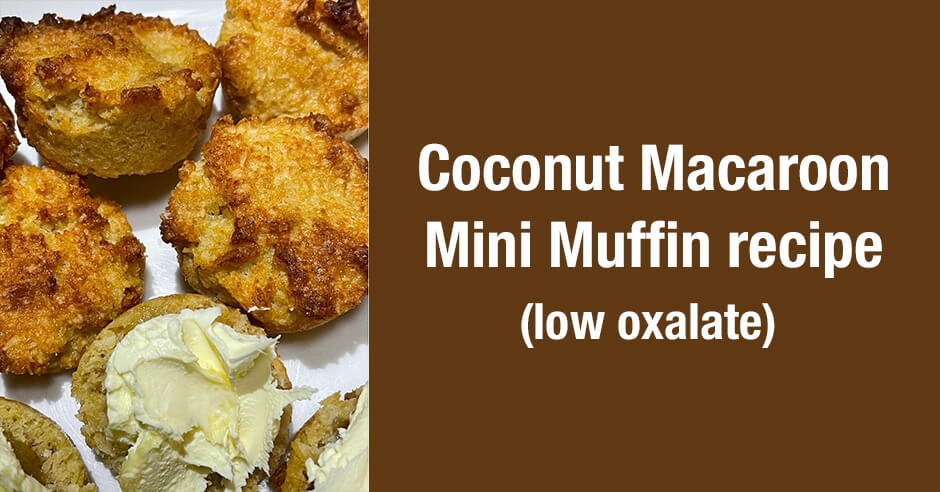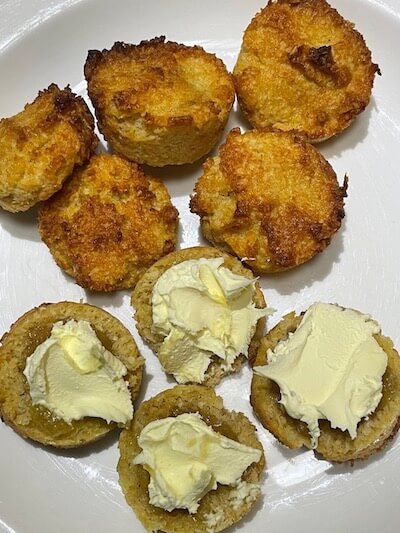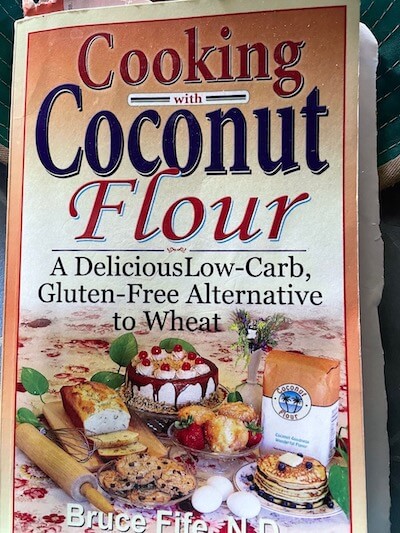
If you have dietary oxalate issues (pain, anxiety, insomnia, restless legs, hearing loss, eye issues, unresolved thyroid issues, bladder issues and more) and yet really miss the occasional muffin this Coconut Macaroon Mini Muffin recipe is a delicious low oxalate option. I see way too many so-called healthy gluten-free recipes that use almond flour and it’s concerning given that almonds are high oxalate foods. If you’re new to the dietary oxalate issues you can read more about this below. I’m finding it to be underappreciated as an issue especially in menopausal women when symptoms seem to be more severe in susceptible individuals. I have also found that using almond flour in baking affects your zinc/copper balance, increasing copper and hence causing more anxiety and even panic attacks.
If you don’t have dietary oxalate issues, you can certainly enjoy this recipe too. The addition of flaked coconut does make it similar to macaroons.
Coconut Macaroon Mini Muffin recipe (a low oxalate option)
Ingredients
1/2 cup melted butter
1/2 cup coconut sugar
4 eggs
1/2 teaspoon vanilla
1/2 cup sifted coconut flour
2 cups coconut flakes
Method
Melt the butter over low heat and add the coconut sugar. Once it’s cooled add the eggs and vanilla. Stir in the coconut flour and coconut flakes.
Spoon the mixture into a greased mini muffin pan. Bake at 375 degrees F/ 190 degrees C for 18 – 20 minutes. The muffins don’t rise at all but will start to turn golden brown. Remove and cool on a cooking rack. Makes 12 mini muffins.
Eat warm or when cooled. Serve with butter and/or cream and/or coconut butter. For a little added sweetness a small amount of raw honey can be spread on a muffin too.


I adapted this recipe from the Coconut Butter Cookies recipe in “Cooking with Coconut Flour” by Bruce Fife ND. I pretty much always do this when I cook – adapt recipes to my needs and likes – and always reduce the sugar. In this instance, I halved the sugar and used coconut sugar.
The original recipe does have a reduced sugar option suggesting using ½ cup of sugar and adding ¼ teaspoon stevia. I’d find this too sweet.
I decided to cook them in mini muffin pans instead of making cookies on a baking tray but you could always try this option. Use the same temperature and cooking time per the original recipe.
They were a little dry (next time I’ll use a little extra butter in the recipe) but eating them with butter and/or cream made them delicious. I tried both – I always like to include some healthy fats. If dairy isn’t tolerated, coconut cream could be substituted. I suspect coconut oil could be substituted for the melted butter but have not tried it.

Here is “Cooking with Coconut Flour” by Bruce Fife ND. You can find it on Amazon here (my link). I’ve baked a number of recipes from this book and I’m impressed. I really appreciate that it’s all coconut flour recipes with no almond flour or other gluten-free flours used.
It’s ideal to keep baked goods – especially the ones shown on the cover of this book – to a minimum. But for an occasional treat this recipe book is excellent.
If you’re new to dietary oxalates as a possible issue
This blog post is a helpful one to start with if you’re new to dietary oxalates and the issues they can cause: Oxalate crystal disease, dietary oxalates and pain: the research & questions
These are the common medium-oxalate and high-oxalate foods that many folks have problems with: nuts, nut-butters and nut-flour (especially baking with almond flour and something to watch when eating Paleo or GAPS), wheat, chocolate, kiwi fruit (very high – see the raphides image on the above blog), star fruit (also very high), beets, potatoes, sweet potatoes, legumes, raspberries, spinach and soy.
In the above blog post, I share an overview of oxalates, my pain issues with dietary oxalates (severe foot pain and eye pain), and deeper dive into the condition called oxalate crystal disease (with some of my insights and questions).
The big take-aways are that calcium oxalate crystals are sharp and can cause far reaching harm beyond pain – such as unresolved anxiety, thyroid issues, neurological symptoms, eye issues, hearing loss, bladder issues, headaches, fatigue, insomnia, restless legs, autism symptoms and more. You can have issues with dietary oxalates and not have kidney disease/kidney stones, although there is very little research supporting the latter.
You may find these oxalate blogs helpful too:
- Increased kidney stones in postmenopausal women with lower estradiol levels. What about increased dietary oxalate issues too?
- Waking in the night due to environmental toxins: impacts on the liver, gallbladder and fat digestion (making oxalate issues worse)
- Butternut Bake recipe (a low oxalate alternative to Potato Bake)
What dietary oxalates issues have you experienced and has a low oxalate diet helped you?
Do let us know if you make this recipe and enjoy it.
Feel free to share a favorite recipe of something you’ve adapted to be low or even medium oxalate.
If you have questions and feedback please share them here too.
Hello Trudy, thankyou for this interesting article. My interest is peaked because I eat handfuls of almonds across everyday. It is my main food item consumed across years. Am I at risk of oxalates? and how strange, I am well read on vitamin and supplementary needs…and currently trying to also find out natural sources of copper. I’m allergic to many foods and quite intollerant to a lot further. So I consume mostly only what doesnt upset me. But I am needing to find out where I can get naturally found copper. I take zinc supplement, but looking to compliment the right amount of copper with it.
What would I be suffering from symptomatically from large daily intake of natural almonds oxalate wise? Thankyou
Deborah
Regarding symptoms caused by dietary oxalate issues, you’ll see some of them in 1st paragraph: pain, anxiety, insomnia, restless legs, hearing loss, eye issues, unresolved thyroid issues, bladder issues and more. I get terrible foot pain and eye pain that affect my sleep. For more in depth info be sure to read the section under the heading: If you’re new to dietary oxalates as a possible issue. And click on the linked articles for a deeper dive into oxalates.
Outside of oxalates eating the same foods over and over on a daily basis set us up for delayed/IgG food sensitivities. But I get it can be challenging when allergic to many foods.
Copper is in many foods. This article has a good list but be aware many are high oxalate too (chocolate, sweet potatoes, tofu/soy, nuts/seeds, dates, guava) https://www.myfooddata.com/articles/high-copper-foods.php Most folks eating quality animal protein (grass-fed meat/liver and wild fish) are getting enough copper.
And keep in mind too much copper counters zinc and leads to increased anxiety. This is especially an issue if someone has pyroluria/social anxiety. More on pyroluria here https://www.everywomanover29.com/blog/pyroluria-questionnaire-from-the-antianxiety-food-solution/
I began eating “handfuls of almonds across everyday” (~2 lbs per week) when I adopted a keto-ish diet a few years ago and ended up with a calcium-oxalate (CaOx) kidney stone earlier this year. Consuming too many oxalates without enough dietary calcium (to promote intestinal binding) and hydration (to avoid supersaturation) with citrates (to discourage renal binding) could lead to problems…
Jim
Glad you’ve made the connection. More about oxalates here https://www.everywomanover29.com/blog/low-oxalate-success-stories-resolution-of-joint-body-pain-insomnia-peripheral-neuropathy-and-can-walk-without-a-cane/
Hi Trudy,
Thanks for an interesting article. Your mention of copper/zinc balance and the connection to anxiety is of particular interest to me. Have you heard of the Root Cause Protocol? It’s in a book called CUre your fatigue as well as it’s own website. The premise behind it is that many of us are lacking Cu (copper) and apparently many ppl that have followed the protocol resolve a ton of health issues, starting with fatigue but also many more. It seems very well researched but also goes against much of what I have learned elsewhere. According to it, supplementing with zinc initially helps ppl feel better, but in the long term actually causes harm. He recommends stopping all zinc supplementation and including various copper rich foods (that I noticed are sometimes zinc rich too, like beef liver). He doesn’t recommend supplementing with copper. It seems that even ppl previously diagnosed with pyroluria have done well on it and gone on to become RCP (root cause protocol) consultants. I’m curious if you have looked into this diet and if so what yiu think think of it. I was thinking of trying it, but bc I think I have pyroluria, I’m hesitant. Especially after reading your current article about increasing copper causing anxiety. This protocol goes against so much of what I’ve learned but also applying everything I’ve learned hasn’t brought me relief of symptoms so I’m curious if maybe the RCP is on to something. Thanks
Liz
I have heard of this but haven’t had a chance to delve into it. I wasn’t aware that there was a book so thanks for sharing. It’s now on my list to read.
Based on what you’ve shared here, I’m with you about it going against what I know about zinc and copper. But I do acknowledge there are many paths to healing. However, I also am a firm advocate that there is not a one-size fits all approach.
Can you share which copper rich foods are recommended? Bringing it back to the topic of this post, there are many high copper foods that are also high oxalate – like nuts, legumes, sweet potatoes, potatoes, dark chocolate/cacao, soy. Other high copper
And what symptoms you are hoping to address? And what approaches have failed?
Please do keep us posted if you do decide to implement his protocol
Hi Trudy,
The day after reading this article and posting the above comment, I was in terrible muscle pain. I had done some house work, but nothing extreme, nothing that explained the severity of my symptoms. Suddenly, because I had just read this article of yours, it clicked that I had been eating a lot of almond flour based foods. Going gluten-free, almond flour is one of my go-to flours (because I also want to be low-ish carb). It so happened that I had eaten a of almond based foods, both store bought and my own baking. The physical pain, right after ingesting a lot of almond flour over several weeks, after reading your article, it suddenly all clicked together. I can’t thank you enough for bringing this to my attention. Since then I have also joined the Trying Low Oxalates Facebook group and am somewhat gradually going Low Ox. In reading about Low Oxalates I see that there is a low oxalate community, but that there is very little cross-over between that and the rest of the healthy-living community. YOU are one of the very few. I read and follow several sources of health advice, watch summits etc, and had never heard of oxalates outside of your articles. And it took you mentioning it a few times for it to really click. SO THANK YOU SO MUCH! Mostly, one just hears about how healthy spinach, nuts, beets, quinoa, buckwheat, kiwi etc are. I am still somewhat shocked by the 180 degrees in my understanding of the healthiness of these and other foods.
Since eliminating the very high oxalate foods from my diet, the joint pain in my knees that had started a few months ago, has gotten better. I am very hopeful that slowly, a lot of the symptoms I was referring to above will get better: muscle pain, low energy and anxiety being the big ones. This is what I was referring to when I said that despite implementing so much of what I have learned about health, I still have a lot of symptoms. According to what I have read about oxalates, it might not be despite, but rather because of many of the things I have eaten over the years.
As for the Root Cause protocol, I am mostly putting that on hold because it’s too much at once, but I will include some of the suggestions, like having a bit of bee pollen (one of the copper rich foods he recommends), eating liver regularly (copper rich, but also zinc and vit B rich and this allows for a more natural balance of copper and zinc). He recommends not taking B vitamin supplements, but rather nutritional yeast and liver instead. I can see myself trying to do that as well. He also recommends taking food based Vit C rather than Vit C supplements. Given the conversion of Vit C to oxalates, I am seeing another reason to greatly decrease (and replace) the higher doses of Vit C I used to take with more food based supplements. So there may actually be some overlap between the two approaches, but I will have to relook at the Root Cause Protocol from a low ox perspective.
P.S. I actually just posted my first question on the TLO Facebook group and mentioned your article in it 🙂 Thank you again, you may have saved me from descending even further into what was starting to feel like 80 in a 40 yr old body (as other low oxers have called it and I fully agree). I literally swap advice on pain relief with my 89 year old grandma.
Liz
So pleased you’re making the oxalate connections (often it takes more than one mention to recognize it may be something to look into) and that you are seeing some relief so quickly. Be sure to read all the oxalate blogs here on my site and please continue to keep us posted.
Thanks too for the Root Cause suggestions he makes. Keep in mind even food based vitamin C can cause oxalate issues.
How do I take L-Tryptophan powder when it doesn’t dissolve in water?
I can see I could mix with a small amount of food, but then it would not be on an empty stomach. I did actually try mixing with a small amount of peanut butter, but had the usual sleep problems, so that didn’t work. Would appreciate ways to get it down my throat. Thanks
Jacqueline
It can be mixed in water even though it doesn’t mix well or taken in mashed banana (medium oxalate) or stewed apple (low oxalate). I actually put tryptophan powder in my mouth and take a sip of water and swish it around before swallowing it.
Keep in mind peanut butter does contain some protein so that would not be a good idea. It is also high oxalate.
what is the nutritional content of these muffins?
Diane
I don’t have this information. If you decide to work it out please do share
Hi Trudy,
How long would you recommend removing oxalates before noticing a difference in symptoms, in particular for restless legs? For a trial to see if it’s the root cause, would 1-3 days be sufficient?
Thanks so much!
Heather
It’s recommended to start reducing high oxalate foods first and then start reducing medium oxalate foods as dumping symptoms can occur in some folks. For some it can take a few days to a few weeks to notice improvements but it’s very variable depending on many factors such as hydration, fat digestion, vitamin B6 status, severity of symptoms, calcium intake, gut health, toxin exposure etc.
As an example, I share part of my journey here – Waking in the night due to environmental toxins: impacts on the liver, gallbladder and fat digestion (making oxalate issues worse) https://www.everywomanover29.com/blog/waking-in-the-night-due-to-environmental-toxins-impacts-on-the-liver-gallbladder-and-fat-digestion-making-oxalate-issues-worse/
Hi Trudy,
Thanks for the Coconut Macaroon Mini Muffin recipe! You mention trying coconut oil as a substitute for the melted butter. In almost every batch of muffins, quick breads, brownies or cake that I make, I substitute the oil component measure for measure with 1/2 melted butter and 1/2 coconut oil. The butter adds richness and the coconut oil gives a nice crispness to the crust.
Cat
Great tip – thanks for sharing. Do let us know if you try this with this recipe. I’m going to.
Hi Trudy,
I have the Cooking with Coconut Flour by Bruce Fife, ND and I am wondering what page is this recipe on and what does he call it?
Thanks so much.
Eileen
Eileen
Coconut butter cookies page 74